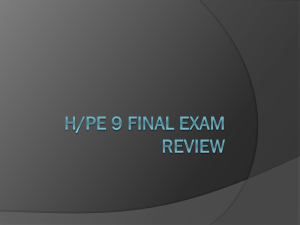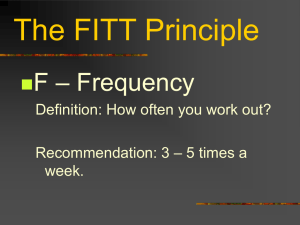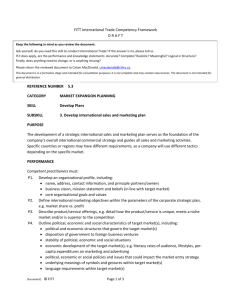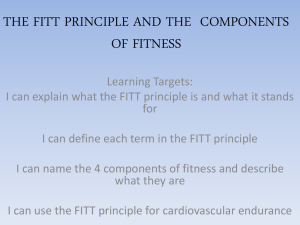Fitness Planning - Glacier Peak High School
advertisement
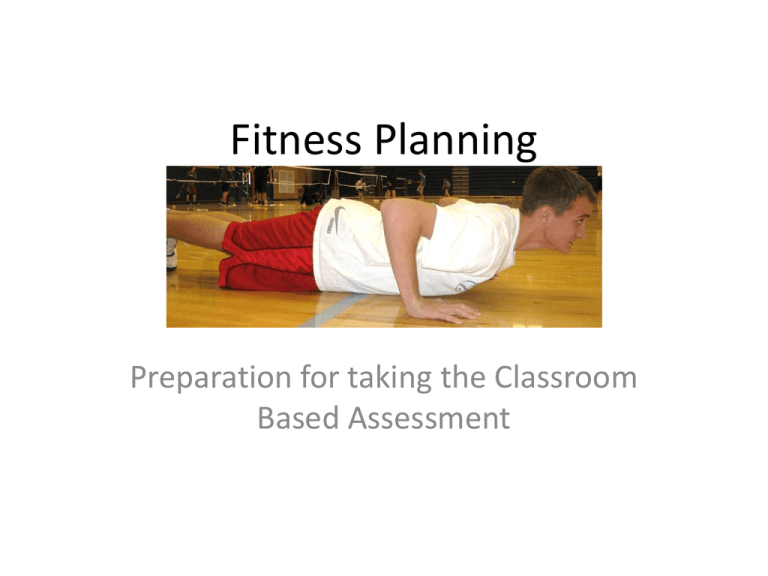
Fitness Planning Preparation for taking the Classroom Based Assessment 1. The 4 active Fitness Components Fitness Component Definition 1. Cardio-respiratory Fitness The ability to deliver oxygen and nutrients to tissues over a sustained period of time. 2. Muscular Strength The ability of a muscle to exert force 3. Muscular Endurance The ability of muscles to perform repeated contractions 4. Flexibility The ability to use joints and muscles through their full range of motion 1 test used for evaluation 2. The 5th Fitness Component • Body composition: The proportion of lean mass (muscle, bone, tissue, and organs) to fat in the body Ways to measure Body Composition 1. Body Mass Index 2. Girth measurements 3. Body fat Percentage 4. Hydrostatic weighing 3. The F.I.T.T. Principle: helping you make a fitness plan What does the letter stand for? What does it mean? F Frequency How often should you perform this exercise each week? I Intensity How hard should you be working during this exercise? T Type What kind of exercises should you be doing? T Time How long (in minutes) should you perform this exercise? 4. Setting realistic and attainable goals by following the SMART acronym: Letter What does that mean? S SPECIFIC. Make your goal as detailed as you can. M MEASURABLE. Place a number in your goal so you can tell if you reached it or not ATTAINABLE. Set your goal high, but not so high that it is impossible. Ask yourself: what am I going to do to attain my goal? REALISTIC. What can you do (realistically) to reach your goal? TIMELY. Place a date in your goal: this puts pressure on you to actually do it! A R T Set your own goals! • Take some time to practice setting a goal in the format that will be on the CBA— remember to use quality answers. What are you going to do to realistically attain your goals? 5a. FITT principle guidelines for Cardio-respiratory fitness FITT acronym F I T T Cardio-respiratory guidelines 3-5 times a week Within your Target Heart Rate Zone: 60-85 % of your maximum HR (220-age) 14 yrs 15 yrs 16 yrs 17 yrs 18 yrs 124-175 123-174 122-173 121-172 120-171 Fast walking, jogging, running, swimming, biking, crosscountry skiing, workout on cardio-machines (elliptical trainer, stair stepper) Minimum of 20 minutes of being in the Target Heart Rate Zone. 5b. FITT principle guidelines for Muscular Strength and Endurance FITT acronym Muscular Strength Muscular Endurance F 2-3 times a week 3-4 times a week I A workout schedule that increases the amount of weight- (high weight, low reps) 8-10 reps A workout schedule that increases the amount of weight (low weight, high repetitions), at or above 8 reps T Increasing the amount of time to allow for building strength Increasing the amount of time to allow for building strength T Lifting weights, carrying heavy items, adding resistance to activities Pilates, running, bodyresistance activities (push ups, situps, etc.) 5c. FITT principle guidelines for Flexibility FITT Acronym Flexibility F I Every day Stretch until you feel a “tug”— increasing your range of motion At least 5 minutes—increasing the amount of time to increase flexibility Using all major body groups: static stretching, dynamic stretching, yoga T T What’s next? • FITT principle practice assignment • Classroom Based Assessment: creating your own personal fitness plan
